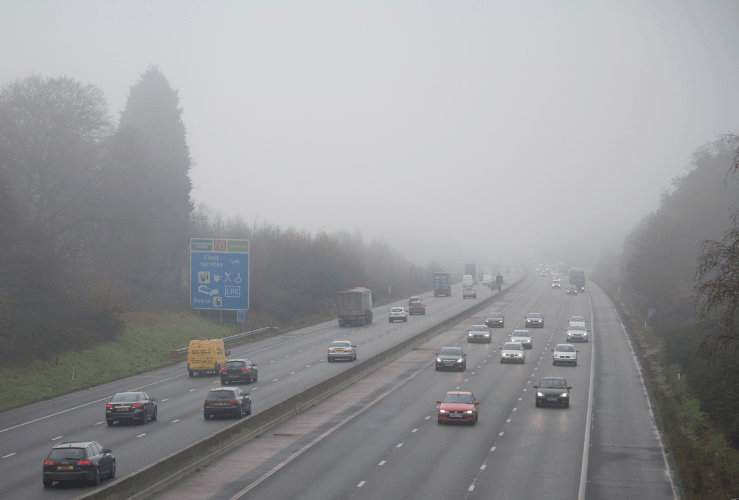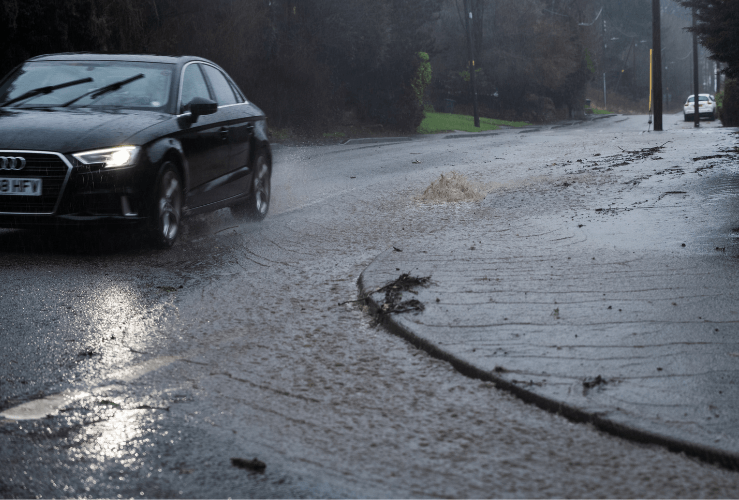Certain weather conditions can impact how well your vehicle performs, increase hazards, and reduce your reaction times (as well as those of other road users).
Read our quick guide to how different types of weather affect driving - and what you can do to stay safe on the road.
Credit: Piranhi - stock.adobe.com
Driving in rain
Rain can affect vehicle performance and reduce visibility.
Even a moderate amount of rain can affect your vehicle's performance and reduce visibility.
Stopping distances double in the rain, so it's important to keep well back from the vehicle in front so you have time and distance to react.
You should also keep your speed down, turn your wipers on, use dipped headlights (particularly in low visibility), and keep a lookout for standing water, which can cause aquaplaning and impact steering.
Do not drive through flood water, as it may be concealing hazards.
Ensure you are paying attention to the road ahead; spray from other vehicles can reduce visibility quickly. Understand that other road users could be struggling to see hazards, too.
Keep a safe distance from vulnerable road users such as cyclists and motorcyclists, as well as pedestrians - all of whom can get blown around when rain is accompanied by wind.
Find out more about driving in heavy rain and floods.
During thunderstorms, strong winds can unsettle other vehicles, so make sure you keep back.

Driving in windy conditions
Wind can affect vehicle stability, and lay debris on the road.
Wind, whether encountered on its own or with a rain or thunderstorm, can be hazardous to motorists.
High-sided vehicles and motorbikes are especially vulnerable to high winds. If you drive such a vehicle, it may be safer to delay your journey. If the wind picks up while you are driving, consider pulling over somewhere safe and waiting for it to pass.
Stay focussed on the road ahead; debris from fallen or damaged trees could be lying on the road or become airborne.
Avoid exposed sections of road if you can - especially if you are driving a vulnerable vehicle such as a lorry or caravan.
Wind may cause towed vehicles to 'snake' - when the towing car and the trailer/caravan become out of sync.

Driving in Snow and ice
Snowy, icy conditions increase braking distance, may impact visibility, and make pulling away difficult.
Snow and/or ice on the road can drastically increase braking distances - by at least a factor of 10. And if snow is falling while you are driving, visibility will be impacted.
You should reduce your speed when driving on snow or ice, so you have more time to react to any hazard.
Additionally, tyres with low tread depths will suffer from worse braking performance. As such, tyres should be replaced in good time.
Braking on icy road surfaces can send your vehicle into a spin, particularly when moving downhill. Instead, ease off the accelerator and shift into a lower gear.
If you need to drive up a hill in the snow, pull away in second gear - and stay in the highest gear possible. Driving in higher gear will give you more control. Pulling away in first gear will give you the highest degree of wheel spin.
Vehicles with all-wheel-drive, higher ground clearance and advanced safety technology are better for driving on snow and ice. Conversely, vehicles with rear-wheel-drive, a lighter frame and lower ground clearance are least suited to such conditions.
Note that underinflated tyres can increase the likelihood of skidding and increase braking distances.

Driving in fog
Fog reduces visibility for you and other road users.
In the UK, fog is more common in autumn and winter months, and can drastically reduce visibility for road users. Naturally, this makes driving hazardous.
If fog is forecast in your area, or it has already formed, the safest option is to delay your trip until it has cleared.
However, if you drive into a foggy area, you should use dipped headlights, wipers and demisters - and rescue your speed. Do not use a full beam, since this reflects light off the fog and reduces visibility even further.
The Highway Code states you should use your headlights if visibility is less than 100m, and turn on fog lights only when visibility is seriously reduced (and under 100m).
Note that other drivers may not be using their headlights.
Remember to keep your speed down, increase the gap between your vehicle and the one ahead, and use your mirrors when slowing down.
If you feel it is dangerous to proceed, pull over somewhere safe and wait for it to clear.

Driving during hot weather
Higher temperatures can impact reaction times and cause vehicle overheating
Driving in high temperatures can severely impact reaction times. A survey by SEAT found that driving in 35 degrees may lower drive reaction times by as much as 20% compared to driving in 25 degrees.
Take advantage of your vehicle's air conditioning system to keep you and your car cooler.
Cars left standing in the sun for long periods may be more liable to overheat when driven. With this in mind, it’s best to open the doors and windows for a minute before setting off. This should cool down the car's moving parts, and decrease the amount of work the aircon needs to do (which reduces energy use and it's better for the environment).
To keep your car cooler while parked, it's a good idea to park under a tree or other source of shade.
Tyre pressure should be optimal in higher temperatures (as with other seasons). Tyres whose pressure is too low can experience blowouts. An underinflated tyre cannot flex sufficiently to handle changes in the surface of the road.
Own an electric vehicle? Here's some top tips on caring for your electric car in hot weather.

Leaves
Leaves can be as slippery as ice.
While falling leaves are not a weather condition in themselves, they can have a similar impact on motorists as ice, since they can be very slippery.
When driving over fallen leaves, keep your speed down, and avoid hard braking and sudden acceleration.
Leaves may also conceal hazards.
Leaves are not uncommon on the UK roads during the Autumn months, here we also look at other considerations when driving in Autumn.





